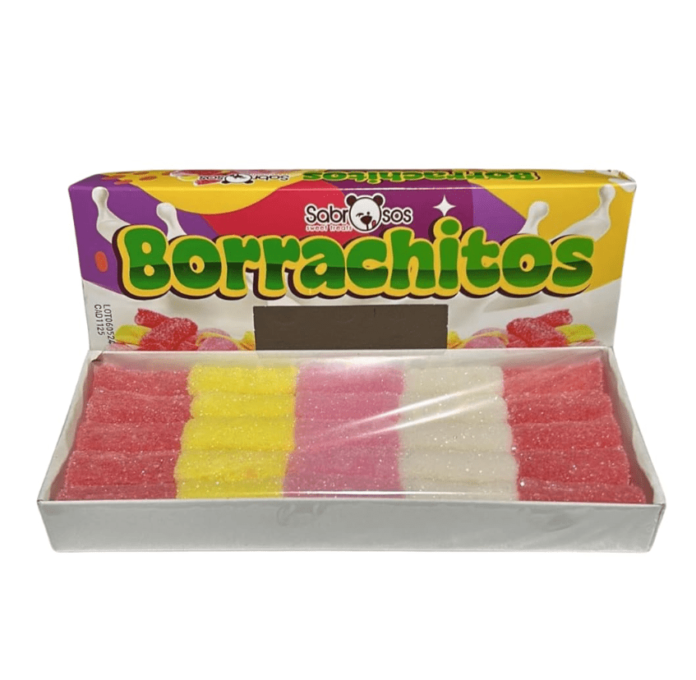With their sweet and slightly alcoholic taste, borrachitos are a distinctive and well-liked kind of Mexican candy that have pleased generations. The name of this classic confection comes from the Spanish word “borracho,” which means “drunk,” and alludes to the candy’s distinguishing feature—a hint of alcohol. Borrachitos, which are made with a foundation of sugar, cornstarch, and gelatin and are usually flavored with tequila, rum, or brandy, are a distinctive treat that combine sweetness and a hint of spiciness. This article explores the history, composition, preparation methods, cultural relevance, and variations of borrachitos, emphasizing the reasons they are still a beloved staple of Mexican cuisine.
Also Read Articles: Who Is Troy Dendekker? The Story of Bradley Nowell’s Wife
Table of Contents
History and Origins
In Mexican culture, burritos have a lengthy history. It is thought that the state of Puebla, which is renowned for its extensive culinary traditions, is where the dish first appeared. These candies were first created several centuries ago in convents and neighborhood kitchens utilizing basic, easily accessible materials. Borrachitos got their unique moniker and distinguishing feature—a dash of alcohol—when the recipe was modified throughout time. Not only does Mexican food use alcohol in its sweets, but many other cultures have also long used alcohol to bring out the tastes of candies and pastries. Spirits like tequila and mezcal, which were readily available and used in both culinary and traditional medicine, are said to have had an influence on the Mexican habit of adding alcohol to borrachitos.
Components and Methodology
The intricacy of borrachitos‘ flavor is concealed by the simplicity of their ingredient list. The main ingredients are sugar, gelatin, cornstarch, and a small amount of alcohol. While brandy, rum, or tequila are frequently called for in classic recipes, the choice of alcohol can vary and contributes to the candy’s distinct warmth and subtle bitterness.
Step-by-Step Setting Up
- Combining the Base: To make a smooth, syrupy base, first dissolve the sugar and gelatin in water. Then, to give the candy its chewy texture, cornstarch is added to the mixture.
- Alcohol Addition: After the base mixture is prepared, a tiny quantity of alcohol is cautiously mixed in. In addition to giving the candy a distinct flavor, the alcohol keeps it fresher longer.
- Flavoring and Coloring: Natural extracts such as lime, pineapple, or vanilla are frequently used to flavor traditional borrachitos. The candy is given a brilliant color boost by the addition of food coloring. Generally speaking, every hue has a distinct flavor, offering a range of flavor experiences.
- Forming the Candy: The material is rolled into cylindrical forms or poured into molds, then allowed to cool and solidify. The candies are covered in granulated sugar after they have solidified, which adds another layer of sweetness and a sparkling appearance.
- Final Touches: Depending on personal style, the candies are typically left plain or sprinkled with powdered sugar after they have set.
Cultural Importance
In Mexico, borrachitos are more than simply a candy; they are a staple of family customs and cultural festivities. They are frequently offered during joyous events like quinceañeras, weddings, and religious holidays like Día de los Muertos (Day of the Dead). Borrachitos are a symbol of happiness, excess, and a hint of mischief, so having them at these occasions is a great way to celebrate laughing and good vibes.
Symbols in Festivities
Food has a lot of symbolic value in Mexican culture, and borrachitos are no exception. Their use of alcohol is thought to heighten the festive mood and be in line with the Mexican belief in savoring every moment of life. For instance, on Día de los Muertos, borrachitos may be placed on altars (ofrendas) in remembrance of departed family members, asking them to partake in the festivities with their preferred meals and beverages.
Variations & Disparities by Region
Although Puebla is famed for its traditional borrachitos, other parts of Mexico have created their own variations, each with distinctive twists and local flavors. Here are a few well-liked versions:
- Fruit-Flavored Borrachitos: To give the candy a tangy sweetness, some recipes call for adding fruit purees or natural fruit flavors like guava, strawberry, or tamarind.
- Borrachitos covered in chocolate: For a richer pleasure, certain varieties of borrachitos are covered in chocolate, which balances the richness of the cocoa with the little bitterness of the alcohol.
- Non-Alcoholic Borrachitos: For individuals who want a softer flavor, there are non-alcoholic versions of traditional borrachitos, even though alcohol is one of its main ingredients. These are excellent for kids and others who don’t drink alcohol because they are frequently prepared with the same basic ingredients but don’t include spirits.
- In contemporary: variations of the traditional recipe, borrachitos can be mixed with a variety of spirits, such as mezcal, flavored liqueurs, or even vodka, providing a variety of tastes and intensities.
Popularity and International Attractiveness
Borrachitos are becoming well-known throughout the world among fans of authentic Mexican desserts. They can be found at gourmet confectionery boutiques outside of Mexico, as well as in specialty food stores and Mexican candy shops. The novelty of the candy is its unusual blend of alcohol and sweetness, which is uncommon in conventional sweets and frequently surprises and pleases those who sample them.
Function in Mexican Food
Borrachitos, in the larger context of Mexican cooking, are an example of the nation’s creative use of tastes and ingredients. They are an example of how colonial-era European influences were combined with native culinary customs. Because of this fusion, there is now a wide variety of sweets that are always changing. Among them, borrachitos stand out as a unique delight that strikes a balance between tradition and inventiveness.
How to Savor Churros
Although they go well alone, brachitos can also be combined with other dishes and beverages. Their somewhat alcoholic flavor goes well with aged spirits like tequila or rum, and they are a great addition to coffee or tea. Borrachitos can also be served with fresh fruit and ice cream to create a pleasant contrast of textures and flavors, or as a garnish for desserts for people who want to cook.
How to Store Borrachitos
The easiest way to preserve borrachitos is to keep them at room temperature in an airtight container. To keep them from getting sticky or losing their shape, keep them out of the direct sunlight and strong humidity. Borrachitos are a perfect treat to keep on hand for special occasions or anytime a need for something sweet arises because, when stored properly, they may last for several weeks.
Conclusion
More than just a candies, borrachitos are a beloved component of Mexican culture that combine the comfort of a little alcohol with the joy of sweets. They are an exceptional delight that sticks out in the world of confections because of its vivid colors, chewy texture, and unusual flavor. Borrachitos are still a favorite among people who love authentic Mexican flavors, whether they are consumed during a joyful event, presented as a gift, or just enjoyed as a sweet treat. Their ongoing appeal is proof of Mexico’s rich culinary legacy, where innovation and tradition coexist together in each mouthwatering taste.




